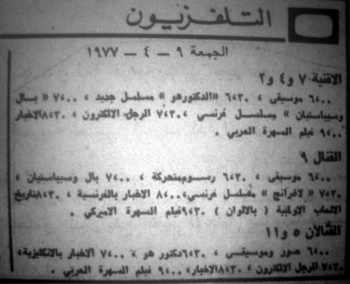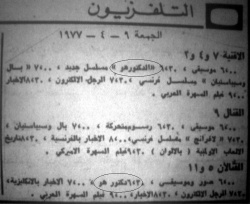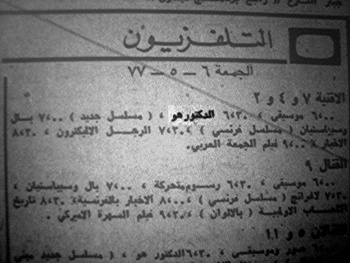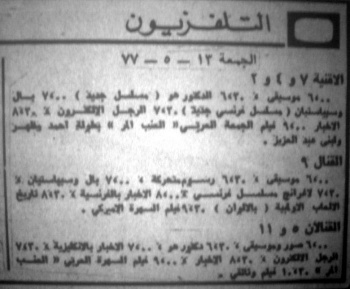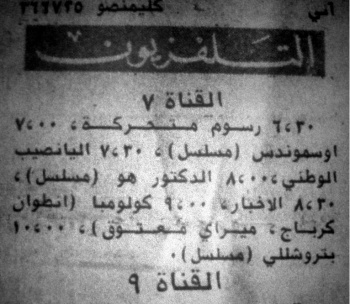Difference between revisions of "Lebanon"
Jon Preddle (talk | contribs) |
Jon Preddle (talk | contribs) |
||
| Line 41: | Line 41: | ||
==Language/s== | ==Language/s== | ||
| + | [[File:Lebanon Arabic 1.JPG|thumb|right|350px|'''الدكتور هو''' in Arabic, Al-Anwar, 29 April 1977]] | ||
| + | [[File:Lebanon Circled.JPG|thumb|right|250px|Both listings for ''' الدكتور هو ''' circled]] | ||
| + | [[File:Lebanon Arabic 4.JPG|thumb|right|350px|New Episode ''' بمسلسل جديد | ||
| + | << الدكتور هو>> ''' 8.30 - in Arabic, Al-Anwar, 29 April 1977]] | ||
| + | [[File:Lebanon Arabic 2.JPG|thumb|right|350px|'''الدكتور هو''' in Arabic, Al-Anwar, 6 May 1977]] | ||
| + | [[File:Arabic listing.JPG|350px|thumb|right|'''الدكتور هو''']] | ||
| + | [[File:Lebanon Arabic 3.JPG|thumb|right|350px|'''الدكتور هو''' in Arabic, Al-Anwar ,13 May 1977]] | ||
| + | [[File:Lebanon TV.JPG|thumb|right|350px|French listings Dr Who – simulcast on Canaux 7,4,2 and 5; L'Orient le Jour, 22 April 1977]] | ||
| + | [[File:LebanonArabic5.JPG|thumb|right|350px|'''الدكتور هو''', Al-Nahar, 11 August 1977]] | ||
The principal languages of Lebanon are [[Arabic]] and French. Television broadcasts are also provided in English. | The principal languages of Lebanon are [[Arabic]] and French. Television broadcasts are also provided in English. | ||
| Line 82: | Line 91: | ||
Three stories, 18 episodes: | Three stories, 18 episodes: | ||
| − | + | ||
| − | |||
| − | |||
| − | |||
| − | |||
| − | |||
| − | |||
| − | |||
{| {{small-table}} | {| {{small-table}} | ||
|- | |- | ||
| Line 128: | Line 130: | ||
==TV listings== | ==TV listings== | ||
{{airdates-left|}} | {{airdates-left|}} | ||
| − | TV listings have been obtained from the French newspaper ''L'Orient le Jour'' and the Arabic | + | TV listings have been obtained from the French newspaper ''L'Orient le Jour'' and the Arabic papers, ''Al-Anwar'' and ''Al-Nahar''. |
Although a French paper, the ''Le Jour'' episode titles for the series were in English! | Although a French paper, the ''Le Jour'' episode titles for the series were in English! | ||
Revision as of 04:32, 9 September 2012
LEBANON is a Middle Eastern country, on the east Mediterranean Sea.
Profile
| Country Number (43?) | 1977 | SECOND WAVE |
| Region | Middle East | |
| Television commenced | May 1959 | |
| Colour System | 1975 | SECAM |
| Population | 1977 | 3.5 million |
| TV Sets | 1978 | 420,000 |
| Language/s | Arabic and French | Dubbed |
Television Stations / Channels
Lebanon began its television service in May 1959.
The first television station was La Compagnie Libanaise de Television (CLT) on Channels 7 and 9 (later adding Channels 4 and 2).
In 1962, a second broadcaster was established, Compagnie de Télévision du Liban et du Proche Orient (Télé-Orient) broadcasting simultaneously on Channels 5 and 11.
In the early 1970s, when both stations experienced financial difficulties, they would sometimes broadcast the same programmes simultaneously. (This practice was still being utilised in early 1977, because Doctor Who was broadcast on both stations.)
Channels 5 and 7 (which occasionally showed the same programme) generally had regionally or locally-produced Arabic programmes or dubbed series imported from the West. Channel 9 was mostly western fare in English or French.
Colour broadcasts commenced in 1975, using the SECAM system.
Following the Civil War in 1975, it took many months before the government had established some stability. Both television stations continued to broadcast during the conflict, but transmissions were limited due to damaged equipment and transmitters. It wasn't until December 1976 that regular television broadcasts resumed. Doctor Who screened in early 1977 during this period of restructure.
In late 1977, the two stations, with the Lebanese government as a third partner, merged to form Télé-Liban.
Language/s
The principal languages of Lebanon are Arabic and French. Television broadcasts are also provided in English.
BBC Radio's Arabic Service had a production centre in Cairo, Egypt, but following the 1956 Suez war, the department re-located to Beirut, Lebanon until the 1975 civil war.
Due to the popularity of BBC radio programmes in Arabic countries it wasn't surprising that BBC would later offer its television programmes to the same market.
In the 1950s, ARAMCO (see Saudi Arabia) had its foreign programmes subtitled in Beirut; and during the 1960s, Lebanon became the centre of the Arab world for subtitling and dubbing. One of the Beirut-based companies responsible for dubbing programming was called Al-Ittihad Al-Fani Studios. The name Al-Ittihad Al-Fani (or its spelling variant Al Ettihad al Fanni) roughly translates as The Art Union or The Union of Art.
The company name can be heard in the Arabic narration of the foreign language alternative soundtracks on the DVDs of Inside the Spaceship and The Aztecs. (See the page on Arabic language.)
A bit of background to Al-Ittihad Al-Fani Studios can be read here:
DOCTOR WHO IN LEBANON
الدكتور هو
Lebanon was, as far as we can tell, the 43rd country to screen Doctor Who, and the ninth in the Middle East (see Selling Doctor Who).
BBC Records
The Seventies records a sale of "(3)" stories by 28 February 1977. The Handbook identifies these as being the William Hartnell serials A, E and L.
The Eighties - THE LOST CHAPTERS records a sale of "(5)" stories (by 10 February 1987).
In DWM, Lebanon is identified in seven story Archives: A, E, L, AAA, BBB, CCC and EEE.
Although there are three William Hartnell stories recorded in the 1977 sales document, there is no firm evidence that the series did screen prior to 1977. From the listings that have been found, the only stories that screened in Lebanon were three Jon Pertwee stories.
It's possible the word "Lebanon" in the 1977 memo was a miss-reading of "Libya", which is not named in the 1977 memo. After all, the television station of the former, "Liban/Libanaise", is very similar to that of the latter, "Libyan"... Or, the error lies in the very simple fact that the episodes were dubbed into Arabic in Lebanon.
Stories bought and broadcast
JON PERTWEE
Three stories, 18 episodes:
| AAA | Spearhead from Space | 4 |
| BBB | Doctor Who and the Silurians | 7 |
| CCC | The Ambassadors of Death | 7 |
Lebanon therefore bought part of GROUP A of the Jon Pertwee stories. Other BBC records indicate that Inferno and Terror of the Autons were also purchased (as noted in The Eighties and DWM), but those sales were subsequently cancelled following the restructuring of the Lebanese television services in late 1977.
The programme was most likely supplied as 16mm black and white film prints. These may have been supplied with Arabic soundtracks per Huw Wheldon's comments in the 1974 edition of the WRTH.
Origin of the Prints?
Lebanon and Saudi Arabia both purchased a run of Jon Pertwee stories at the same time.
Transmission
JON PERTWEE
الدكتور هو
The first billing appears in the paper for Friday, 22 April 1977 at 6.30pm, however it appears that the series was delayed a week, otherwise there would be eight episodes for the first serial.
The series therefore (presumably) started a week later on Friday, 29 April 1977, at 6.30pm. It was simulcast on the two rival stations, CLT Canaux 7,4,2, and on Télé-Orient Canal 5. (An alternative it that the series did start on 22 April, but that one of the subsequent six episodes was pre-empted.)
The first serial to air was Doctor Who and the Silurians. This was followed by The Ambassadors of Death. With part five of that serial, the series moved to Thursdays (from 14 July 1977), at the later time of 8.00pm.
The third and final serial to air was Spearhead from Space, from 11 August 1977. That serial concluded on 25 August.
There were only two further listings for Doctor Who in the paper – on 1 and 8 September 1977 - but it appears that these episodes did not screen, as by this time the restructure of Lebanese television was underway. Doctor Who was dropped from the schedules, and the two other Pertwee serials that were purchased did not screen.
There is no clear record that Lebanon ever screened Doctor Who again.
TV listings
| ← AIRDATES ...... (CLICK ICON TO GO TO TABLE SHOWING EPISODE BREAKDOWN AND AIRDATES - N/S = story title is Not Stated) |
TV listings have been obtained from the French newspaper L'Orient le Jour and the Arabic papers, Al-Anwar and Al-Nahar.
Although a French paper, the Le Jour episode titles for the series were in English!
The series was called "Dr Who" for most of the listings, but the French spelling "Docteur Who" was used three times. The billing for 21 July was for "Docteur No"!
The first serial was called "Dr Who and the Silbrians" (sic) or "Silvrians" (sic). The Ambassadors of Death was in the singular – "Ambassador".
Some of the listings from Canal 5 gave the timeslot as one hour, but the same listing for the other channel was only half an hour.
In the Arabic text – which reads right to left - the programme title is followed by text - بمسلسل جديد - which translates as "New Episode".
